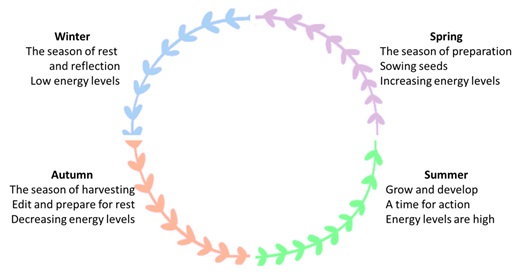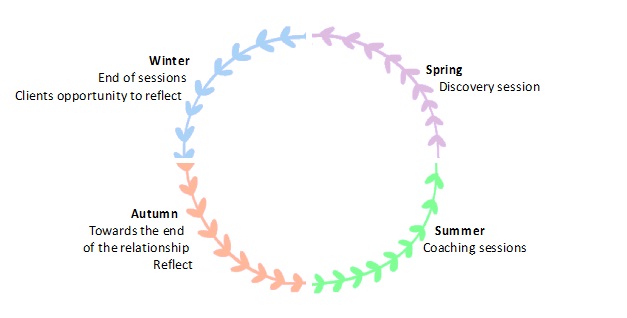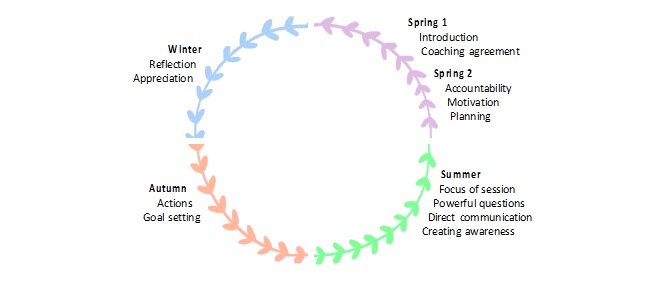A Coaching Model Created by Colleen Cluett
(Life Coach, UNITED KINGDOM)
Summary
My coaching model uses the seasonal cycle as a framework for the cycles that we each experience. It can be applied to our lives as a whole, to each year (following the natural seasonal cycle), each month, and, even, each day and is something I use in my own life. Here I describe this approach and build on its application to my business and to work with my clients through our entire relationship and in each session.
Introduction
We are all familiar with the four seasons- spring, summer, autumn and winter, and their characteristics. Although we may experience them differently and at different times of the year based on our location, each of these seasons provides opportunities and has impacts, for life and each is required to maintain the balance of life as we know it.
As humans have adapted our environments to our needs over time, we have lived in increasingly humanized environments. In these environments, we can lose touch with the variations in and seasonality of our natural environment. An example of this is our access to heating, electricity and imported foods, especially seasonal fruits and vegetables, in winter which enables us to maintain the longer days and eating habits that we would normally only experience in summer. In these environments, we can forget the lessons, opportunities, and impacts of the seasons, that we humans have adapted to throughout our evolutionary history (Foster and Roenneberg, 2008; Stevenson et al., 2015).
We, as a society, have tended to prefer the high energy and production of the spring and, especially, summer seasons. The implications of this are now being explored (e.g. see Stevenson et al., 2015). However, there is many of us have lived experience or have heard from people who have experienced that if we spend all our time being highly productive, energetic, and outwardly-focused (summer), we eventually burn out. The appreciation of the negative effects of over-work and under-rest is growing and has led to an upturn in the amount of research, writing, and awareness on this topic. The areas of mindfulness, balance and digital minimalism, to name a few, have become increasingly widespread and people and employers are taking note and incorporating this into our lives and terms of employment (e.g. see Bostock, 2019; Creagan, 2004; Goodman and Schorling, 2012; Roeser et al., 2013; Goldhagen et al., 2015; Abenavoli et al., 2013; Hyland, Lee, and Mills, 2015; Aikens et al., 2014).
I believe that not allowing ourselves time to experience each season fully has led to some of the unsustainability that we see in our own lives, in society, and the use of our natural environment. Examples are unsustainability in our work-life balance and personal habits; our focus on the outside world, appearances, and consumerism and our over-use of resources leading to many of the environmental crises we see today. Through my model, I use the seasons as a framework for how we live our lives, to create balance, rhythm, and awareness, and to live our lives with connection, joy, and intentionality.
The seasonal framework can be used at multiple scales- over a day, a week, a month, a year, or over a lifetime. In this model, I focus on the application of this framework to a, roughly, monthly cycle, and my coaching practice and relationships.
I was first introduced to this concept through Menstrual Cycle Awareness and have used this framework in my life to great personal, and inter-personal, benefit. This benefit has led me to incorporate this framework into my business and message. I believe that the seasonal framework can help us to improve our personal, societal, and environmental sustainability and, as a result, to improve our well-being and fulfillment.
Attributes of each season

Figure 1: Generalised depiction of the seasons
Figure 1 shows a brief depiction of the characteristics of each season. Energy and production levels increase through the spring to a peak in summer, before decreasing through autumn to their lowest point in winter.
These characteristics are discussed in further detail below. I have chosen to start with winter in my description because this is the season that marks the start of a menstrual cycle. In practice, it is difficult to distinguish the “first” season.
Winter
As the nights grow longer and the cold seeps in, winter is an opportunity for rest. Many trees release their leaves, seeds often overwinter in the soil, and certain animals hibernate.
We can use this opportunity to rest, to reflect, to increase our gratitude practice, and to think about what comes next.
Spring
Spring is a time of rebirth, perennial plants and deciduous trees grow new leaves, annual plants germinate and grow, some plants blossom, hibernating animals re-emerge and for others, this is the birthing season. We are surrounded by signs of new life.
We can use this rebirth to plan, explore, learn, and to prepare for and (slowly) start to take action.
Summer
Summer is the season of growth and production. Plants and animals are highly productive. Plants invest in growth and create fruit. Animals also focus on growth and on helping their young to become more self-sufficient.
We can use this energy for action. Create, build, develop, network, etc. during this period of high energy and outward focus.
Autumn
Autumn is the season to prepare for winter. As the nights become longer, plants’ fruits ripen and drop and animals may hoard food or further increase their consumption in preparation for winter.
We can use this time to refine what we have produced in our summer and to prepare for rest.
Applications
Personally
I was first introduced to the concept of our internal seasons through Menstrual Cycle Awareness. In Menstrual Cycle Awareness, the different phases of the cycle have been aligned to a different season (e.g. Baker, Adore Your Cycle).
Menstruation is winter, pre-ovulation is spring, ovulation and the days around it are summer and post-ovulation and pre-menstruation is autumn. Each of these phases has different characteristics, energy levels, mood, etc. Over a few years, I have used this information and tailored it to myself. I use the knowledge available as a guide and connect it to my experience. As with anything involving humans or life in general, my cycle, circumstances, and mood differ each time but this information serves as a lens to gain clarity about where I am and how I can best show up in the present time. It also serves to help me plan for the upcoming weeks and months. Figure 2 below indicates my actions through the course of a typical cycle. (Upward pointing arrows = increase; downward pointing arrows = decrease)

Figure 2: How I use the seasons in my life
During spring and, especially, summer I focus on growth, outward energy, and action. During autumn and, especially, winter I focus on reflection, refinement, and rest. This practice has transformed my life, my self-compassion, and my sense of fulfillment. It has become a keystone of my life and because of this, as I contemplated my coaching model, I knew I wanted to incorporate it. This application is illustrated below.
Coaching Application
My business
I align my business work to my menstrual cycle. During my spring, I feel excited, optimistic, resilient, and gutsy, so I focus on planning, learning, new opportunities, and new clients. I also sometimes do a final review and publish big projects from the previous cycle(s). During my summer, I feel quite nurturing and have high energy, I also still have high resilience and that gutsy feeling. I use this to focus on more mentally taxing work, writing, networking, and workshops. During my autumn, I start to move slower, there are one or two days of being self-critical and then I generally feel pretty relaxed but more reserved and less resilient. I use this time to focus on administrative work (during the self-critical periods) and then to edit other work. Sometimes I will publish work although I often wait until after my winter reflection and when I’m feeling more resilient. During my winter, I feel very tired and generally sore for the first day or two, after that I feel calm, reflective, and deeply connected to myself. I use this time to reflect, rest, and to connect with my intuition and inspiration regarding what is next. This is summarised in figure 3 below.
Understandably, there are certain activities that I can’t only leave for one week per month- seeing clients, for example. I carry on engaging with these activities and emergent, urgent tasks throughout my cycle but the awareness of where I am and how I am feeling serves me to be fully present in those spaces. Also, it can help to determine which emergent tasks are truly urgent and which can wait until a better season.

Figure 3: How I use the seasons in my business
I also apply the seasonal framework to my interaction with my clients, both at the scale of our coaching relationship and within a session. This is enormously flexible and responsive to the needs of the client. However, it provides me with a lens through which to understand the journey and, in my niche as a Life and Sustainability coach, it serves me as a framework to ensure balance and, crucially, sustainability. Below is how I view this through the coaching relationship and each session.
Relationship
Figure 4 below illustrates my use of the seasons for the coaching relationship with a client. I treat our discovery session, and in cases the early sessions, as Spring. The is a time for goal setting and planning. I view our coaching sessions as our summer, a time for creating, nurturing, and growing. Towards the end of our coaching relationship, we enter autumn, a time to edit and reflect together. After our coaching journey is winter, this is a time for me and the client to reflect separately on the journey we have undertaken and, possibly, to gain inspiration for the next journey.

Figure 4: How I use the seasons in the coaching relationship
Session
My use of the seasons during a session is the least structured application of the framework. The length and timing, and even the sequence, of the seasons, vary depending on the client and the session. Figure 5 below shows the general characteristics of each season and a template for their use in a session. As you will notice, there are two springs. That is because I hope that at the end of a session the client will move into the energy, optimism, and enthusiasm of summer.

Figure 5: How I use the seasons in a coaching session
The first spring is the introduction and establishing the coaching agreement for the session. Summer is characterized by the competencies of powerful questions, direct communication, and creating awareness. During autumn actions and goals are identified and set. Winter then arrives as a period of reflection and appreciation before we move into the spring of accountability, planning, and generating further motivation for action.
Conclusion
As I mentioned above, in this model I have focussed on its application for me and within my business and coaching practice. However, this is not the sum of its applicability. The use and application of the seasonal cycle are broad and varied. It can apply to a lifetime, a year, even a day.
I believe that the greatest gift of this framework is in its embodiment of the natural ebb and flow of life. We can use the transformation of nature as a guide and inspiration for transformation in our own lives and as a reminder of the balance that is needed if we are to live a truly sustainable life.
Selected further reading
https://nicolejardim.com/four-phases-of-your-menstrual-cycle/
https://www.juju.com.au/blog/cycle-syncing-how-to-master-your-menstrual-cycle/
References
Abenavoli, R. M., Jennings, P. A., Greenberg, M. T., Harris, A. R., & Katz, D. A. (2013). The protective effects of mindfulness against burnout among educators. Psychology of Education Review, 37(2), 57-69.
Aikens, K. A., Astin, J., Pelletier, K. R., Levanovich, K., Baase, C. M., Park, Y. Y., & Bodnar, C. M. (2014). Mindfulness goes to work: Impact of an online workplace intervention. Journal of Occupational and Environmental Medicine, 56(7), 721-731.
Baker, C. Adore your Cycle.
Bostock, C. (2019). Digital life: value or vice? The journal of the Royal College of Physicians of Edinburgh, 49(4), 295.
Creagan, E. T. (2004). Burnout and balance: how to go the distance in the 21st century. Cancer Control, 11(4), 266-268.
Foster, R. G., & Roenneberg, T. (2008). Human Responses to the Geophysical Daily, Annual, and Lunar Cycles. Current Biology, 18, R784-R794.
Goldhagen, B. E., Kingsolver, K., Stinnett, S. S., & Rosdahl, J. A. (2015). Stress and burnout in residents: impact of mindfulness-based resilience training. Advances in medical education and practice, 6, 525.
Goodman, M. J., & Schorling, J. B. (2012). A mindfulness course decreases burnout and improves well-being among healthcare providers. The International Journal of Psychiatry in Medicine, 43(2), 119-128.
Hyland, P. K., Lee, R. A.& Mills, M. J. (2015). Mindfulness at work: A new approach to improving individual and organizational performance. Industrial and Organizational Psychology, 8(4), 576-602.
Roeser, R. W., Schonert-Reichl, K. A., Jha, A., Cullen, M., Wallace, L., Wilensky, R., … & Harrison, J. (2013). Mindfulness training and reductions in teacher stress and burnout: Results from two randomized, waitlist-control field trials. Journal of Educational Psychology, 105(3), 787.
Stevenson, T. J., Visser, M. E., Arnold, W., Barrett, P., Biello, S., Dawson, A., … & Evans, N. (2015). Disrupted seasonal biology impacts health, food security, and ecosystems. Proceedings. Biological Sciences, 282(1817), 20151453-20151453.